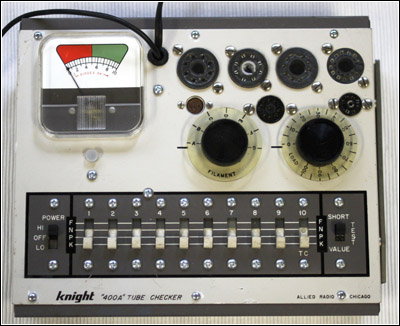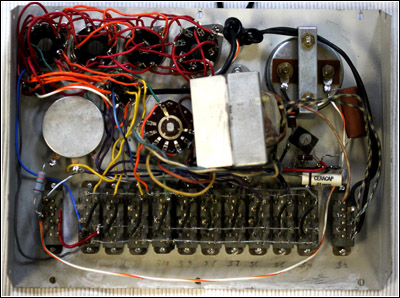Of Old Radios And Related Items--Published Monthly
Knight Kit Model 400A Tube Checker
By Howard Hood
WEB EDITION
A couple of dollars and a willingness to do a fair amount of restoration work buys a very satisfactory tube tester, as Howard Hood proves in the following article. (Editor)
A visit to a local Ham radio swap meet turned up a Knight Kit 400A tube checker, the one shown in Figure 1. The price was certainly right -- a whole two dollars. The low "as is" price made me a little suspicious that maybe the meter or some other irreplaceable part was shot, but it was worth a chance at only two dollars
Allied Radio called the Model 400A an "economy" tube checker kit. It uses the emission-type test circuit which could quickly and accurately test over 1,300 tube types for cathode current flow, shorted elements, and filament continuity. The 400A is capable of testing nuvistors, novars, 10-pin, octal, and loctal tubes, as well as 7-pin, and 9-pin miniatures.
Tube data is on flip-over cards located in a drawer on the side of the tester. Tube condition for good or bad is read on a two-color meter while an indicator light shows continuity of the filaments and shorts between elements. The 400A is rather small measuring only three inches tall by ten inches wide by eight inches deep. It weighs in at approximately five pounds.
Figure 1. The Knight Kit 400A service-type tube tester by Allied Radio purchased at a Ham swap meet for two dollars.Restoration
The outside of the tester did not look too bad. There was a very small amount of rust in a few places, and some hardware had a little corrosion, all easily corrected. Inside was another story. I have purchased many kits over the years at swap meets but the soldering on this tube checker was a new experience. There were cold solder joints, no solder on joints, solder on only half the joint, flux-only joints, blobs of solder shorting socket pins and many burned wires. There is no way this kit could have ever worked correctly.
I decided to get the manual and do a complete check of the entire unit. I ended up repairing about 75 percent of the solder joints, correcting two wiring errors, replacing many burned wires, and one out-of-tolerance resistor. Luckily the critical components of the checker, the meter and transformer, tested good. Figure 2 shows the interior of the 400A after restoration.
Final Testing
For the final check-out, I chose a Type 6F5 tube. It checked in the green for emission with a value of 90. The 400A indicated that no shorts were present and that the filaments were good. While the testing was in progress, I decided to check some additional tubes, and then repeat the tests on several other emission testers and get a comparison. For this part of the testing I used another 400A, along with a Heathkit IT-21 and an Eico 655. The test results, based on 100 as the full scale reading, were as follows:
6F5 12SG7 35L6GT 400A #1 (restored) 90 40 64 400A #2 90 40 64 IT-21 85 45 64 655 80 40 50 The results were quite good. All the testers compared favorably, certainly good enough for radio service work. No shorted elements were found with any of the test sets. The 12SG7 failed in all four checkers, while the 6F5 passed in all four checkers. The 35L6GT passed on the low side in three checkers, but got a marginal from the Eico 655. In general, the accuracy of an emission type service tester is only about 15 percent.
A Little More on Tube Checkers
Tube checkers fall into two basic classes. The first class tests the ability of the cathode to emit electrons -- the emission tester. The second class tests tubes by giving an indication of how efficiently a tube operates as an amplifier -- the mutual conductance tester.
The emission tester is a very simple design and tests total emission of the cathode by a DC test with the plate and all grids tied together. It is easy to use, inexpensive, and will locate weak or bad tubes quickly, about all you really need for radio repair work. Most emission testers also include features such as leakage/short testing and filament continuity testing. Emission-type tube checkers can generally be picked up at swap meets in the range of $25 to $50.
One caveat here is that tube checkers vary in the type of tubes they will test. If your restoration work deals with radios from the early 1930s, be sure the instrument you are considering will test the 4, 5, 6, or 7-pin tubes you need. The 400A does not test these older type tubes.
Figure 2. An interior view of the 400A after restoration and the reworking of almost all solder connections was complete.Mutual conductance testers for the most part can be considered lab-type equipment, used to test quality, or the specification of new tubes. AC signals are applied to the tube under test which closely simulates actual operation conditions -- very useful if you intend to work on communications equipment. Mutual conductance tester cost runs into the hundreds of dollars.
Helpful Testing Information
Here are a few pointers that may improve your test results with a service type emissions tube checker:
1. Allow tubes to warm up two to three minutes before testing.
2. Test for leakage and shorts first. Stop the test if leakage or shorts are indicated. This will prevent test equipment damage.
3. Tap the tube under test for leakage and shorts gently with your finger. This will reveal any loose elements.
4. Unless directed otherwise by your manual, hold the test switch for about 15 seconds to allow the meter reading to stabilize.
Summary
For two dollars and a little work, I got a tube checker capable of testing about 1,300 tube types from the late 1930s through the 1960s.
Although emission tube checkers only test for emission and shorts and not how the tube would function in a circuit, they are still a good choice for radio restoration. The majority of tube failures result from low cathode emission, open or shorted heaters. The emission tester is very effective in detecting these types of tube failures.
References:
Allied Radio 400A Tube Checker Assembly Manual.
Prensky Sol D. Electronic Instrumentation. Englewood, N.J.: Prentice-Hill Publisher, 1963.
Tomer Robert B. Getting the most out of Vacuum Tubes. Howard W. Sams Publisher, 1960.
Howard Hood retired after 39 years as an electronic integrated systems mechanic for the Department of Defense. He holds both FCC Radiotelephone Operator and Ham licenses. He began radio collecting in 1980 and specializes in wooden cabinet radios of the 1930s and 1940s.
|
[Free Sample] [Books, etc., For Sale] [Subscribe to A.R.C./Renew] [Classified Ads] [Auction Prices] [Event Calendar] [Links] [Home] [Issue Archives] [Book Reviews] [Subscription Information] [A.R.C. FAQ]URL = http://www.antiqueradio.com/Mar10_Hood_Knight.html Copyright © 1996-2010 by John V. Terrey - For personal use only. Last revised: March 2, 2010. For Customer Assistance please contact ARC@antiqueradio.com or call (866) 371-0512 toll free Antique Radio Classified |

